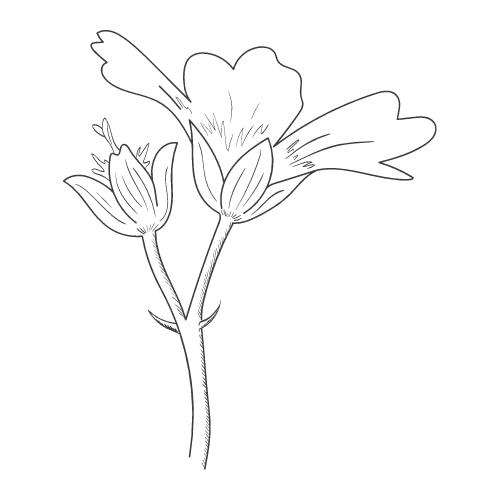These bite-sized sponge cakes are light and airy, with a soft and delicate texture. Ladyfingers are the ideal cookie for using in tiramisu, trifles, and parfaits, though they are just as yummy by themselves with an afternoon tea.
Ladyfingers are fairly easy to make (with the help of detailed recipes like mine!), and it’s much cheaper to make your own. Plus, you don’t have to hunt them down at supermarkets, as they can be tricky to find on occasion.
These cookies use only flour, sugar, eggs, vanilla extract, and powdered sugar for an easy yet delicious cookie you can make in about an hour!
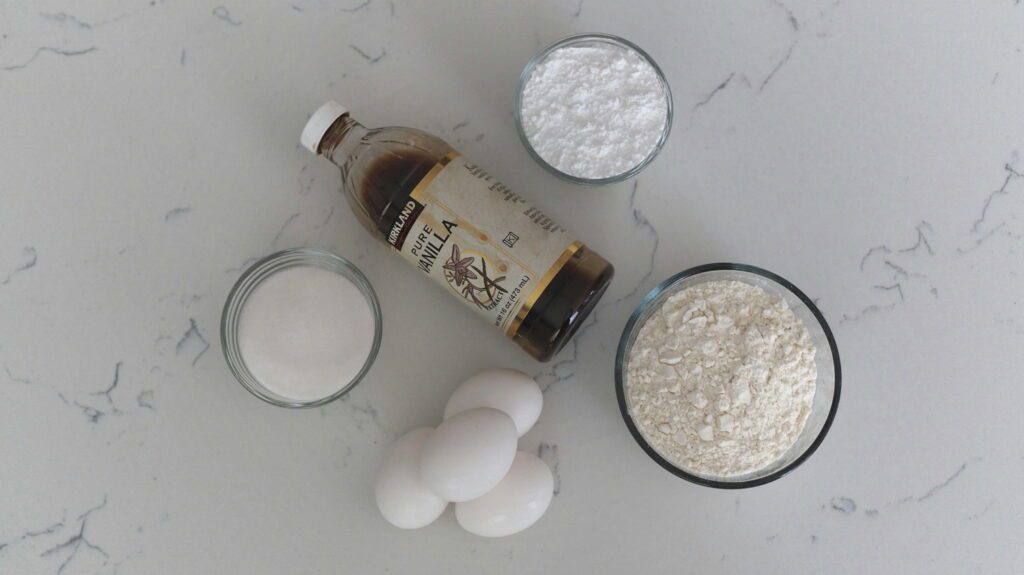
Quick Tips for Prepping Ladyfingers
Would you rather watch these tips than read them? Watch my video on making ladyfingers!
The key to getting a light and fluffy cookie is in the eggs. Because this recipe has no leavening, all the height is coming from the eggs, which need to be whipped well. I use the traditional method of whipping egg whites and sugar into a meringue in one bowl and whisking egg yolks and sugar in another. Your meringue should be firm enough to hold its shape, and your yolk mixture should be slightly thicker and have a few bubbles. See the photo below for an example.
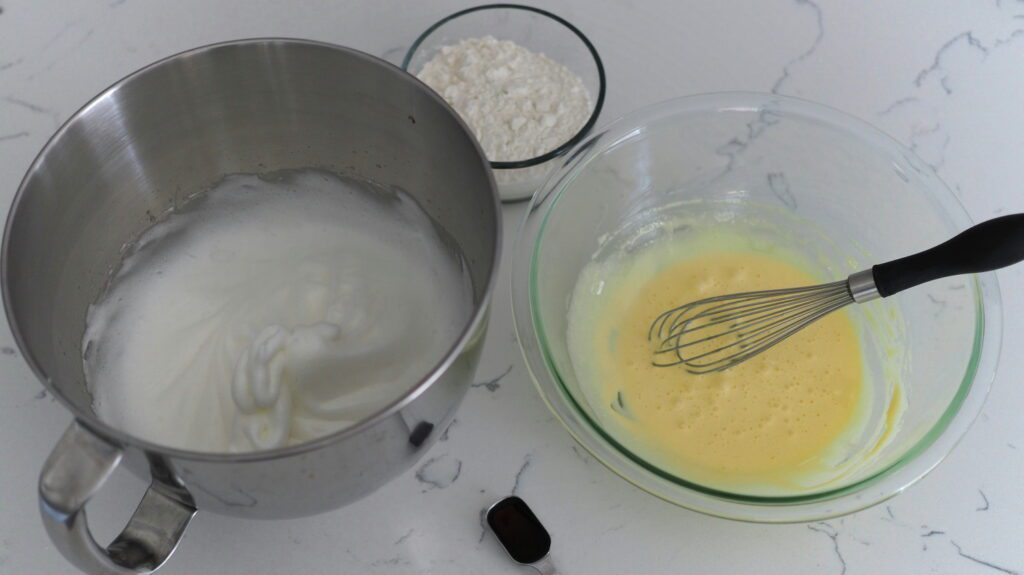
When mixing the meringue and yolk mixture together, use a light hand. Though it seems counterintuitive, stirring too hard can knock some of the air out of the mixture. If it’s your first time and you’re concerned about deflating the mixture, start slow by adding in only half of the yolk mixture to the meringue. Fold gently until only a few yellow streaks remain, then fold in the rest of the meringue.
Once the flour is mixed in, the batter will resemble a sponge. It may take some time to get there, as flour tends to enjoy hiding inside clumps of meringue. I typically go through two or three “final” stirs because I always find hidden pockets of flour. Scrape the sides and bottom of the bowl well as you fold, and look at the texture to tell when it’s fully combined.

I’ve made ladyfingers with and without the powdered sugar dusting. When baked, the powdered sugar forms a thin, crackly topping. It’s a delightful texture when eating plain. If you’re planning to dip them in any sort of sauce, I would recommend skipping the dusting. The sugar flakes off while handling and can make a perfectly tempered and smooth chocolate dip look crumbly (speaking from experience!).
Did your piped lines come out a little squiggly? It can be difficult to get straight, crisp edges on each and every cookie. I’ve found that lightly running the tip of a butter knife along a wobbly edge of batter does wonders to straighten it out! Then dust with powdered sugar (if desired) and bake as directed.
The process of making ladyfingers has a lot in common with the process of making macarons. These cookies, however, are far less temperamental. If you’re having difficulty mastering the steps for macarons, I’d suggest making ladyfingers for practice. Once you’ve excelled at making the meringue, folding flour gently into the batter, and piping the batter evenly, try your hand at macarons again!
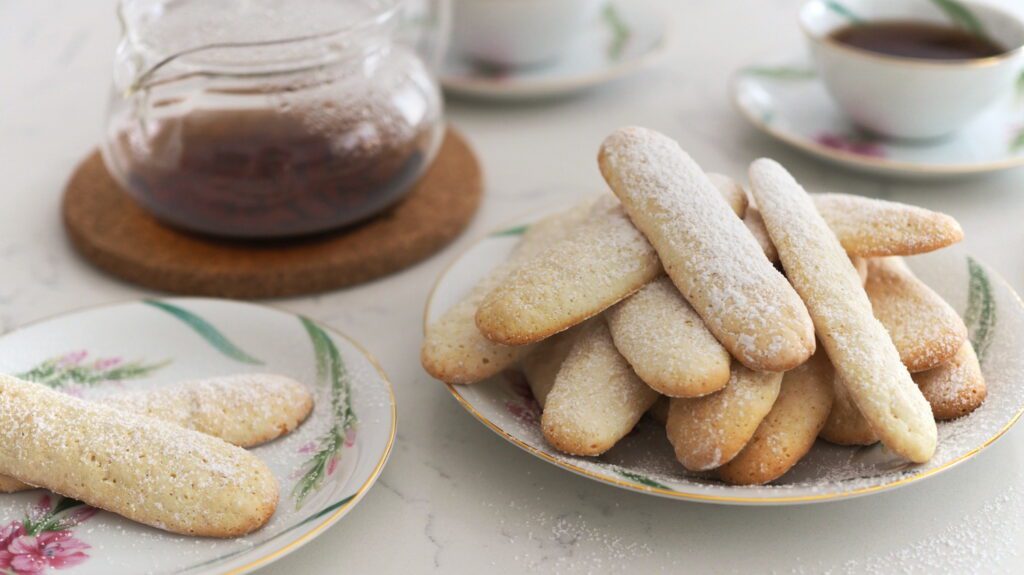
Dish Cleanup: Not Too Bad
I rank my recipe clean-ups on a scale of 1 to 5. 1 is only a handful of dishes, and 5 is everything including the kitchen sink.
These ladyfingers are a 2. There are a few dishes, but the cleanup overall isn’t too bad. If you use dishwasher-safe bowls and utensils, you’ll spend hardly any time at the sink.

Ladyfingers
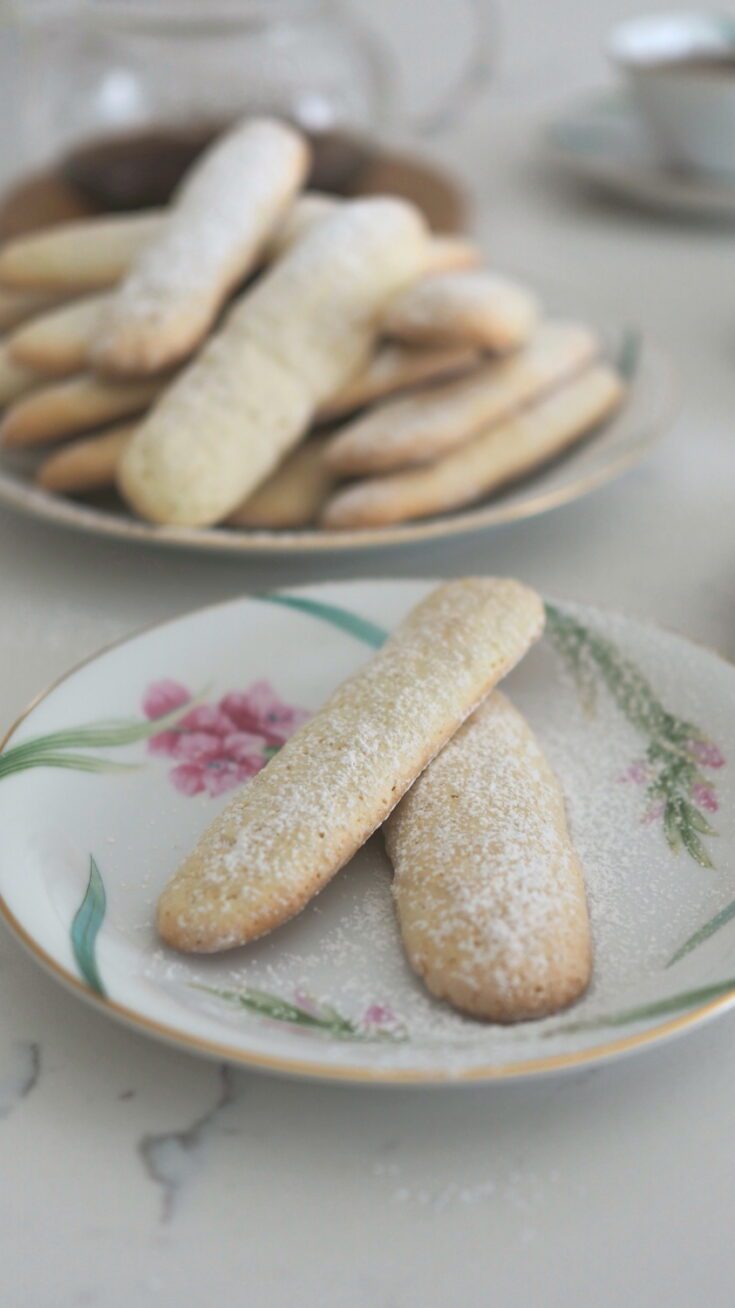
These bite-sized sponge cake biscuits are light and airy—ideal for using in tiramisu, trifles, and parfaits.
Ingredients
- Four large eggs
- ½ cup sugar, divided (100g)
- 1 teaspoon vanilla extract
- 1 cup flour (145g)
- Powdered sugar, for dusting
Instructions
- Preheat the oven to 375°F. Line two baking sheets with parchment paper.
- Separate the eggs, placing the yolks in a medium bowl and the whites in the bowl of a stand mixer.
- Using a stand mixer fitted with the whisk attachment, begin to whisk the whites and ¼ cup sugar to firm peaks, about 5-10 minutes depending on your speed. To test if your meringue has firm peaks, turn off your mixer, then remove and invert the whisk attachment. The meringue should mostly hold its shape, with only the very top folding back on itself.
- Whisk together the yolks and ¼ cup sugar until the mixture is thoroughly aerated and pale yellow. Then stir in vanilla extract.
- Use a light hand in this step: With a spatula, transfer the yolk mixture into the meringue. Fold to combine (light yellow streaks are fine).
- Sift the flour on top of the meringue mixture and fold to combine, taking care to scrape the bottom and sides of the bowl. When thoroughly mixed, the batter will have lots of air bubbles, much like a sponge. If it doesn't, go on a gentle search for hidden pockets of flour.
- Transfer the batter into a piping bag fitted with a round tip (I used Wilton #12). Holding the bag at a 45° angle from the pan, pipe straight lines about an inch apart, each about 1 inch wide and 5 inches long.
- Dust with a layer (or two!) of powdered sugar for a crackly outer shell, and then bake for 13-15 minutes or until a light golden brown on the edges. Let cool entirely on the pan and then store in an air-tight container.
Notes
If your piping is a little rusty, you can use a knife to straighten out your ladyfingers before baking. Gently run the tip of a butter knife alongside a wobbly edge to even it out a bit.
Nutrition Information:
Yield:
12Serving Size:
2 ladyfingersAmount Per Serving: Calories: 134Total Fat: 2gSaturated Fat: 1gTrans Fat: 0gUnsaturated Fat: 1gCholesterol: 62mgSodium: 24mgCarbohydrates: 26gFiber: 0gSugar: 18gProtein: 3g
The nutrition facts are estimated and may vary based on specific ingredients used.
Thanks for trying out my ladyfinger recipe! I’d love to see how they turn out: Take a photo and tag me on Instagram @floralapronblog or tag it with #floralapronbakes.
Other Recipes You May Enjoy
Try these ladyfingers as a substitute for store bought, and you’ll never go back! Use them in popular no-bake dessert dishes like tiramisu, parfaits, and trifles. Or eat them on their own as a teatime snack.
Use them as a decoration around my tiramisu layer cake, filled with real tiramisu cream and coffee sponge cake!
If you enjoyed this recipe, check out some of my other desserts. (I’m adding recipes every month!)
Happy baking!
